A summary of our webinar with the Northeast HR Association (NEHRA)
When it comes to health and productivity programs, the past several years have been a time for Benefits and HR professionals to test out a range of initiatives in response to pandemic and post-pandemic challenges, priorities, and employee expectations. Now, however, the market is in a different place and it is time to assess the impact of recent program offerings; does the reward outweigh the risk?
The Big Picture
Today’s economy is creating urgency around making sure benefits programs are properly managed. High inflation rates touch everything; the impact doesn’t stop at the grocery store or the gas pump, it extends to already high healthcare costs. In addition to the economic reality, we have seen an increase in healthcare utilization coming from new treatments and technologies available, further increasing costs. Relatively low unemployment may have shifted attraction and retention goals for some organizations, but a rise in layoffs is having tangible effects on the labor market at large which trickles down to employer strategies. It’s not just employers facing challenges, though, as healthcare services have become unaffordable for many and consumers/employees are also feeling the cost burden.
As a starting point, take a look at your data to answer questions like:
- What does your population look like in terms of demographics and health trends?
- What are your employees selecting for benefits?
- What is driving your costs?
- How might you segment your population?
- Are you accounting for future population shifts and resulting needs (e.g., company growth)?
You should then be able to assess whether or not your benefits align with your population as well as your corporate objectives. When determining true return on investment (ROI), it’s important to consider both human and financial perspectives.
Now that we have established a bird’s eye view of the risk versus reward equation, let’s drill down into key plan components that factor in.
1. Risk Management
There are a range of risks to consider within your benefits strategy. There is the risk of buying insurance, and the allocation of funds. There is the risk to your employees of undertaking a high cost treatment, if necessary, which may not be feasible for lower wage workers.
When it comes to benefits funding, the following graphic illustrates the spectrum of options available, where the risk taken by the employer increases as you move toward the right.
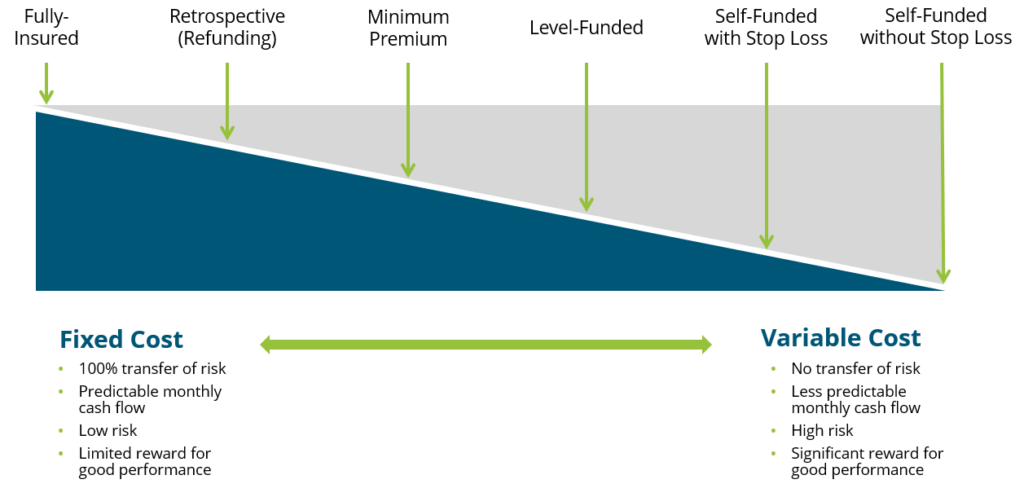
While a fully insured plan largely frees the organization of risk, there is typically a lot of overhead and administrative costs involved and less governance when it comes to claims management. Overall, though, we encourage our clients to consider this spectrum and determine where they fit in related to risk appetite, budget and resources, specific health trend, and more.
2. Financial Management
Related but separate from risk management comes the financial management of your benefits program(s). There are three key activities that fall within this bucket:
- Program Strategy
- Account for long-term costs and variability
- Cost Projections and Rate Setting
- Provide budget updates
- Adjust for economic changes
- Includes premium equivalent rate projections and employee contribution rate setting
- Plan Governance
- Establish framework
- Ensure sufficient reporting and monitoring cadence
- Account for actual versus expected, large claims reporting, key cost drivers, retiree medical valuations, etc.
The insights gleaned from the financial management arm should be embedded into your overall benefits and risk management strategy, rather than live in a silo.
3. Pharmacy
Pharmacy has been top of mind for employers, understandably so given the rapid rise in prescription drug costs, which now constitute anywhere from 20-25% of total healthcare spend in the U.S. Specialty medications account for 50% or more of pharmacy spend even though only about 2% of the population is using them. Brand and generic drug costs are also rising at rates we have not seen in the past, perhaps in correlation with inflation. Suffice it to say, employers are struggling to mitigate their own costs as well as the costs for their employees. So, what can be done?
Within the pharmacy benefits landscape, two areas have been getting a lot of attention: weight loss drugs and biosimilars.
Weight Loss Drugs
Chances are you’ve heard about a new wave of “Hollywood diet” drugs. There has been an enormous amount of marketing going on around these new weight loss drugs, especially in the realm of social media and influencers. All of the buzz has also gotten the attention of employers, who are asking us questions surrounding coverage, costs, and pros and cons.
To provide some background, of the four weight loss drugs taking center stage, only two have indications for weight loss, while the other two are being used off-label. Weight loss drugs are not new, but these varieties are showing results we haven’t seen before, and their arrival on the market is timely, as about 42% of the population is either overweight or obese.
From a health and productivity standpoint, we know that obesity increases a person’s risk of developing a chronic condition, which leads to higher healthcare costs. But we also know that there are financial and non-financial reasons to foster a happy and healthy workforce. Can and should weight loss drugs be an answer for employers?
These new drugs are retailing for about $1,300 a month, so we need to consider annual costs and the longevity of how long an employee will need to stay on the medication. For employers considering them to their plan, we recommend it being one piece of a comprehensive strategy that also includes wellness initiatives and/or a commitment from those prescribed the drug. In addition, you must build strong monitoring protocols to judge effectiveness and impact on overall plan costs and utilization.
The inclusion of weight loss drug coverage in a health plan will make sense for some employer groups, and not others. We recently talked with an employer client who saw enough value in even a 10% reduction in body weight to convince them to cover the drug. However, any decisions need to be based, once again, off of population data and corporate objectives. This is a new and evolving sector, so your strategy should remain fluid as we see developments.
Biosimilars
Biosimilars are non-generic alternatives to those specialized medications that are very targeted in how they work and on what conditions they combat. There has been a lot of anticipation surrounding biosimilars as a solution to the specialty drug cost crisis. At the beginning of the year, a biosimilar of Humira, the number one drug dispensed in the U.S. which is used to treat inflammatory conditions, entered the market as the first biosimilar. While there has been some impact, to date it has not been the silver bullet we were hoping for. We can see below that biosimilar adoption rates are all over the map depending upon the condition for which it’s being utilized.
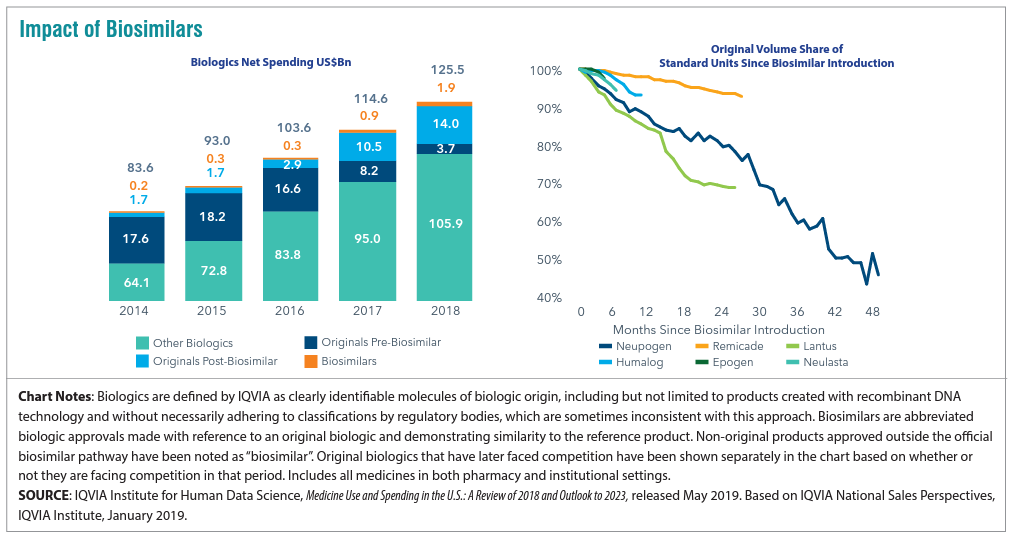
For employers, what’s important is vigilance in understanding where your Pharmacy Benefit manager (PBM) has positioned biosimilars as far as coverage is concerned. We have found that PBMs are placing biosimilars typically at the same parity with the reference, or brand name product. In this case both Humira and its biosimilar would be considered tier 3 medications, which does not yield the anticipated savings. Why is this? Well, there may be additional rebates available to employers and health plans if they continue to use the reference product.
This is a complicated space that continues to change at a rapid pace. Overall, though, if biosimilars are working the way we want them to, we need to figure out a way for all stakeholders to embrace them as a lower cost alternative instead of being locked into brand name drug prices. In some cases, the drugs are life-changing, so we do want to cover them but in a more sustainable way. We work with clients to ensure they are informed of and ready for these advancements and nuances.
4. Targeted Point Solutions
The term “point solutions” now represents a large umbrella of tools, however it typically references programs that target specific diagnoses such as diabetes, oncology, and hypertension. In recent years there has been significantly more interest in point solutions from our employer clients, and, especially with multiple solutions running at a time, these can be a slow leak on spend. Now is a good time to take a step back to answer that risk versus reward question for point solutions.
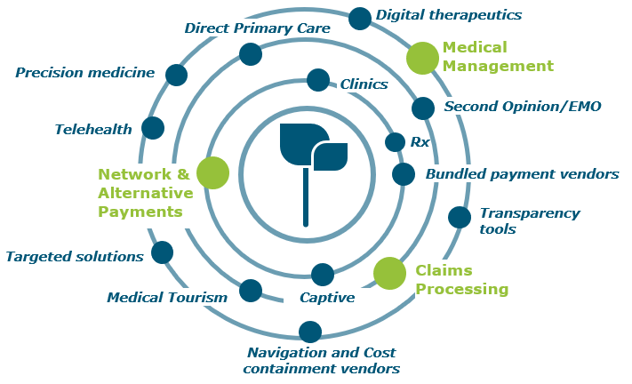
The best place to start in assessing point solutions whose reward outweighs the risk is data analytics. Try to use any data you are getting from your health plan, internal teams, or the industry to benchmark your spend. In areas where your spend is high relative to benchmarks, do a deep dive for potential solutions that can help. Some pitfalls in this area include:
- The more point solutions you implement, the harder they become to monitor and manage
- Point solutions embedded in your health plan may seem like a no-brainer, but they usually yield very low take-up rates
- Overlap between different point solutions/benefits programs can cause confusion for all stakeholders
- Focusing purely on dollar ROI may not be the play; listen to your gut about what is right for your workforce and understand the qualitative advantages around camaraderie and culture to be gained
5. Absence Management
Absence management is highly correlated with your health plan performance, since the vast majority of your high cost claims will also include a leave of absence, so there are both plan costs and productivity rates at play here.
Making absence programs more challenging is the volume of stakeholders involved and laws with which you need to comply (as seen below).
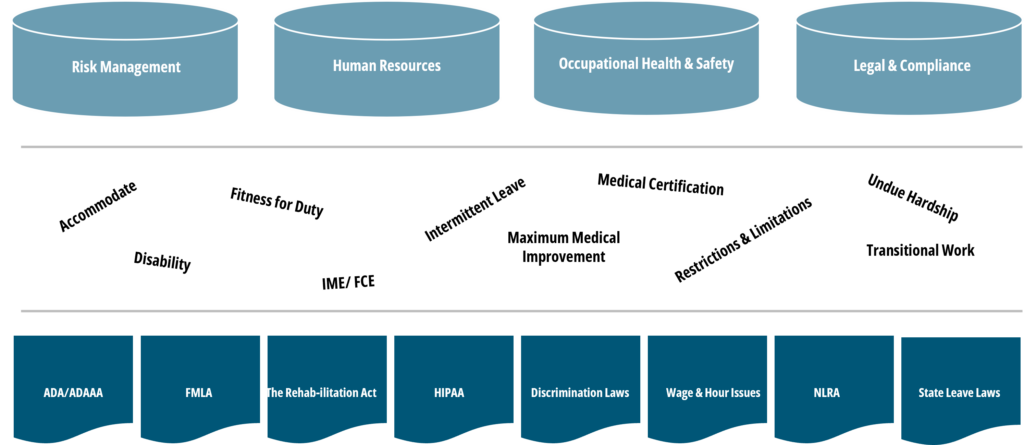
Further, when we talk about absence management, we account for a wide range of benefits including short- and long-term disability, statutory disability, workers’ compensation, FMLA, ADA state paid family and medical leave (PFML), and others.
With absence, different than with medical plans, your company’s managers and supervisors are directly involved when it comes to plan design, governance, staff training, etc., so it is an area where you typically need to look inward to drive change.
When it comes to the risk/reward balance of an absence management program, employers can make sure corporate programs are set up the way they want, for example, promoting the right attraction and retention strategy. Remember that the more generous your programs are, the more they will cost and the higher the risk you take on. If shifting some responsibility to an outsourced partner, be sure you still have monitoring protocols in place.
Closing Thoughts
Across these five areas and more, we encourage you to get familiar with your organization’s plan and demographic data. Depending on your size, the level and depth of data available might be different, but there is always some data available, such as industry standards and benchmarks. Whether you are focused on weight loss drug strategy, funding, or point solutions, you can take those data-driven insights and apply them across these four pillars to determine your best practice.
If you are having trouble getting started, or could use specific guidance surrounding the topics mentioned, please get in touch with our team.
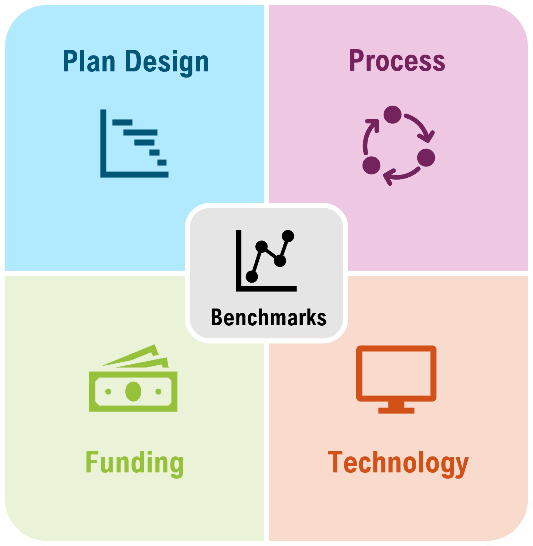
Q: How would you describe the current state of tech in the absence management space?
A: To preface the discussion, I want to quickly illustrate the current state of paid family and medical leave (PFML) regulations. Although eligible employees may quality for the Family and Medical Leave Act (FMLA), the Americans with Disabilities Act (ADA), or other national policies, there is no national PFML program. Instead, many states, municipalities, and cities have developed their own plans. This is positive, but means employers have more and varied regulations to keep up with while managing and integrating internal policies. For this and other reasons, many employers are turning to Leave of Absence (LOA) software to help track employee leave. In layman’s terms, it is software that helps employers manage and track employee absences including sick leave, vacation time, federal holidays, jury duty, etc. Outside of LOA software and services, we are seeing components of absence recording in payroll services, benefits administration programs, time tracking software, HRIS modules etc.
Q: How do employers feel about these developments?
A: We’ve seen many employers embrace these technologies. As an impartial entity, at Spring we provide employers with all options when it comes to Leave of Absence (LOA) software, benefits administration programs and other technology options, including taking a look at internal processes for opportunities to streamline. Our surveys indicate that employees tend to favor newer LOA programs as opposed to traditional, more manual practices. Having a system in place mitigates the stress of trying to figure out what to do and where to go for information about leave options available, or to request a leave. These programs also allow employers to track patterns in utilization of different leave types and critical metrics surrounding return to work and leave duration. In this way, absence management technology can have an indirect impact on employee productivity and morale.
Q: What are some of the limitations/pitfalls to tech in absence management?
A: Although it may seem like we are in the prime of technological innovation, with new devices and tools popping up everywhere, macro advancements are slow to develop. Many LOA systems offer similar services when it comes to recording/managing leave, but the main benefits come from tracking and data analytics. With that being said, leave technologies may not be worth the monetary investment for smaller companies with fewer leaves to manage. Another concern relates to privacy and security, as many of these programs require sensitive company and employee information, but this is no more true for absence management technology than it is for any other digital tool that houses sensitive information We haven’t seen a large-scale breach in this space yet, but it remains a concern for some employers. Lastly, our employer clients have seen the most success with these types of technologies when they have the bandwidth to assign a point person or point team, as appropriate, so that there are in-house experts on the tool that can not only maintain the system and answer questions, but can also be looking for process improvements.
Q: What should employers do if they are considering implementing more tech within their absence programs?
A: I would recommend employers first review their current policies and pinpoint areas for improvement. Some do this through employee benefits surveys, one-on-one interviews, benchmarking, market research, etc. Absence management software ranges drastically and it is essential that employers understand exactly what they are looking for in a tool, before reviewing available options. It is important to first compile any pertinent data related to leaves of absence and a clear line of sight into your different leave benefits and how they interact. Once you have conducted this landscape/needs assessment, we recommend working with a consultant like Spring to conduct a Request for Proposal (RFP) for technology partners, market research to give you a detailed overview of solutions, benchmarking to understand what similar employers are utilizing, and/or surveys to determine the priorities of your employees and stakeholders.
Q: What can we expect to see in the coming months/years?
A: The pandemic completely flipped leave approaches and tools upside down. Many companies have shifted to hybrid and remote models, with a more dispersed workforce than ever. Those offices that have implemented a return-to-office (in-person) policy are seeing an influx of accommodations requests because employees are reluctant to return. Complexities and market shifts like these are what made LOA software the norm among many larger employers, and it remains a viable solution in the post-pandemic world as well. It is difficult to predict macro-economic and social changes, but I predict current LOA technologies will continue to improve and gain traction. I expect we will see more employers reevaluating their absence programs to stay competitive and attract talented workers, and having an employee-friendly system in place is part of that equation.
Although AI, ChatGPT and other groundbreaking technologies are dominating global headlines, the absence management space has remained mostly untouched. But who knows? Maybe one day we will have absence software that can predict our sick days before we even take them. Stay tuned for more food for thought!
As today marks National Insurance Awareness Day, we wanted to share some current trends in the insurance landscape and considerations for businesses. Healthcare costs have skyrocketed for employers, it is estimated in 2023 that healthcare will cost employers $13,800 per employee.1 Over the years, as we have moved in an unaffordable direction, employers are increasingly turning to self-insurance as a mechanism for risk management and control over costs.
In simple terms, fully insured plans consist of employers paying a monthly premium directly to an insurance company to cover their employees (and dependents). On the other hand, with self-insurance, employers take on a set portion of the financial risk of a program instead of paying a fixed premium amount. In 2022, 82% of firms with 200+ workers adopted insurance plans that were wholly or partially self-funded.2 Why is self-insurance so popular today? Here’s a quick snapshot.
Pros:
- Lower potential healthcare costs in the long-term
- Greater customization and flexibility
- Provides faster, more detailed data to drive action
- No change to employee experience
- Recoup insurance carrier profit
Cons:
- Requires more attention and in-house resources
- Increased risk
- Medical stop-loss coverage is highly recommended to avoid catastrophic claims impact
If you are thinking of transitioning to a self-funded insurance model, or have questions about medical stop-loss, please check out our alternative risk financing services overview, or get in touch.
1 https://www.healthcarefinancenews.com/news/health-benefits-costs-expected-rise-54-2023#:~:text=Average%20costs%20for%20U.S.%20employers,to%20professional%20services%20firm%20Aon.
2 https://www.statista.com/statistics/985306/self-funded-health-insurance-covered-workers-by-firm-size-us/
Background
In 2018 the State of Hawaii Legislature passed a bill, Session Law Act 109, directing the Legislative Reference Bureau (LRB) to conduct an analysis to determine the impacts of establishing a state paid family leave (PFL) program. Stakeholders considered in the impact analysis included industry, consumers, employees, employers, and caregivers. The goal of Act 109 was to create a potential framework for the development of a PFL program that would offer paid leave for workers who need to care for a family member. The bill allowed the LRB to contract with a consultant for completion of the impact study, and after a formal Request for Proposal (RFP) process, Spring was selected to partner with the State of Hawaii on this initiative.
The Challenge
The objectives of the impact study were to:
- Conduct an objective and unbiased study analyzing and comparing existing models of PFL programs in other states
- Model the impacts of adopting similar methods of PFL programs in Hawaii, including the projection of costs and other quantifiable effects of each model
- Examine objectively the compliance and enforcement options for a PFL program in Hawaii and make recommendations for additional staffing and support needs
At the time, six states plus D.C. had a paid leave program for family and/or medical reasons in place, and part of our evaluation was not only a cross-model comparison of existing plans, but also a provision of the PFML landscape overall, including states with pending or rejected legislation. Both qualitative and qualitative factors needed to be assessed, including required operational activities, outreach and education approaches, state administration models, headcount modeling, IT infrastructure development, and projected startup costs. Integration with Hawaii’s existing State Temporary Disability Insurance (TDI) program was also explored.
Spring’s Work
Through Spring’s three-phased approach, the impact study covered a wide range of areas in detail that were critical in deciding on the development of a PFL plan in Hawaii. Starting with a deep dive into existing state PFL programs which included California, Massachusetts, New Jersey, New York, Rhode Island, Washington D.C., and Washington as seen below.
Plan Structure:
- Plan model
- Rating method
- Plan design including benefit amount, wage replacement ratio, maximum benefit, length of leave, employer eligibility, employee eligibility, qualifying events, covered relationships, job protection, and interaction with TDI program funding
Funding:
- Taxable wage base for funding
- Contributions to funding
- Updated costs
Administration:
- Administrative structure
- Claims management
- Ongoing monitoring
Implementation Timeline
- Rollout sufficient to gain industry and employer support
- Education and communications strategy
- Protocol for contributions and pre-funding
Within this evaluation, factors like gender equity, hiring practices, speed of benefit payments, ease of making applications or claims, financial sustainability, data collection capabilities, and compliance monitoring capabilities were also assessed. To arrive at these impact answers, Spring’s actuaries developed an actuarial impact model that utilizes actual PFL claim and other industry data to project claim incidence rates, duration of benefits, average benefit payments, expected costs and funding rates under existing state models and Hawaii’s current TDI structure.
The Results
Spring’s comprehensive impact study for the State of Hawaii’s Legislative Reference Bureau is available for public viewing here. Our team presented it in person to various legislators. While the State has not moved forward with a PFL program to date, we continue to keep the dialogue open and all parties are pleased with the framework set out in this project, as it was an imperative piece of due diligence on behalf of the State.
Our Senior Vice President, Prabal Lakahpal, and Senior Consulting Actuary, Nick Frongillo have been listed in Captive International’s Forty under 40. The list is comprised of up-in-coming talent that is helping shape the future of captive insurance. You can access the complete list here.


Employees have a whole host of responsibilities outside of work, and compassionate and strategic employers understand this and act accordingly. Below is our checklist of considerations for an employee benefits program that is family-friendly, enabling work-life balance and lessening the need to choose between job and familial needs, ultimately helping solve for some of HR’s biggest challenges: recruitment, retention, absenteeism, mental health and productivity.
 | Get familiar with your population and demographics o Does your workforce trend younger, older, or a balanced mix? o Are there cultural, regional, or gender-based considerations at play? o Do your claims demonstrate specific health issues among employees or dependents? o Are most of your employees remote, hybrid or on-site? o Does the nature of employees’ work or work schedule present any concerns (e.g., physical labor, night shifts, healthcare staff susceptible to illness)? |
 | Evaluate family-oriented provisions that are already in place via your health plan, corporate policies, voluntary benefits, or wellness programs o Where are there gaps or room for improvement? o Have you accounted for nontraditional families in a way that aligns with diversity, equity, and inclusion (DEI) goals? o What benefits do you provide compared to similar companies with whom you are competing with for talent? |
 | Armed with this information, consider a broad range of benefits or perks: o Paid parental leave (for mothers and fathers), including for adoption o Take it a step further by designing a plan that offers insurance coverage and/or assistance related to fertility treatments, adoption, surrogacy, and post-partum needs o Paid family leave / caregiver leave, for employees to care for aging parents, sick children, partners recovering from surgery, and more o Bereavement leave, so that workers have space to grieve and spend time with loved ones during a time of need o Flextime or alternative work schedules, for daycare pickup, doctors’ appointments, sporting events, and the like o Childcare assistance, such as an on-site facility or a stipend o Eldercare assistance, which could include financial and/or counselling and navigational help o Financial wellness benefits, for traditional use cases like retirement but extending to consider things like tuition, student debt and long-term care planning o Long-term care insurance, or related financial/educational resources, especially as states begin to consider statutory long-term care programs o Paid Time Off (PTO) – in many cases this represents a set number of days that can be used for various reasons, including the fun (vacation) and the not-so-fun o Enhanced mental health benefits or resources beyond standard EAP benefits for all members of the family o Pet insurance or “pawternity” leave – while it may seem offbeat, most pet owners consider their pets to be family members |
 | Identify which family-focused benefits are most appropriate and feasible for your population, and fit with your company culture |
 | Determine your budget or how desired benefits could be funded (e.g., fully funded by employer, fully funded by employee, or some combination) and contribution methods |
 | Understand how different leave types and benefits would integrate with current offerings or if adjustments will be needed (e.g., phasing out sick banks for a more flexible paid time off policy) |
 | Ensure compliance and cohesion with national, state and local policies surrounding family leave (FMLA, state Paid Family and Medical Leave, parental leave policies, etc.) |
 | If appropriate, conduct a Request for Proposal (RFP) for any vendor-provided products or services |
 | Consider engaging a consultant like Spring to guide you through this checklist! |
The Challenge
A private equity group, backed by a family office, was struggling with a piece-meal insurance approach between its 22 portfolio companies representing a diverse range of industries (e.g., hospitality, farming, technology) and related risks. Each entity was purchasing their own insurance individually. Over time, hardening insurance markets caused healthcare costs to increase and the organization’s fragmented structure did not allow for effective cost savings and risk management tactics.
The Goal
At the outset, we worked with the client to establish goals and set expectations. The first order of business was to bring the portfolio companies together into an integrated insurance program that can yield cost savings due to economies of scale. Then, we would explore alternative funding mechanisms for that single entity that would enable customized coverage at reduced rates. The end result would be a holistic view of the risk profiles represented within the organization which would improve enterprise risk management.
The Process
We helped the family office file and establish a captive insurance company to fund employee benefits and property & casualty risks. This included:
- Placing excess coverage for all lines to limit exposure
- Leveraging our strong carrier relationships to negotiate
- Providing M&A due diligence on target acquisitions insurance coverage and cyber security services
- Producing captive financial statements and ROI analysis
- Guiding the firm in selecting best-in-class vendors and acting as a liaison with partners on their behalf to ensure a painless, seamless execution
- Keeping the client up-to-date on regulatory updates from the DOL and other agencies
Based on our analysis, the client decided it would be advantageous to include all Property and Casualty (P&C) lines, medical stop-loss coverage, employee benefits and the family’s personal coverage within the captive program.
The Results
The captive structure enabled great advantages for the client across two significant areas:
- Cost Savings: By unifying its subsidiaries into one large group and moving away from the commercial market, the organization is projected to reduce its total insurance related costs by 25%, with increased coverage.
- Enterprise Risk Management: The parent company now has the sum total of its risk in front of them, allowing for more informed decision-making and a better understanding of their exposures and vulnerabilities across the board. The captive has also diversified the client’s risk and created an improved risk profile, both important for a long-term, stable and successful
A captive can be a valuable unifying tool among diverse family offices and private equity firms, producing lower operating expenditures (opex), enhanced products/services not available in the commercial market, favorable tax incentives, additional cashflow, and a seamless transition from your current model. If you would like to learn more about taking this path for your organization, please get in touch.

Title:
Senior Consulting Actuary
Joined Spring:
I joined Spring in April 2019, around a year before the pandemic.
Hometown:
I was born in Maryland and grew up in both Maryland and California.
At Work Responsibilities:
As a Senior Consulting Actuary at Spring, I provide employers with customized solutions that manage costs and improve performance of employee benefit programs. Some of the most common programs I am involved with include retirement, life, and disability plans.
Outside of Work Hobbies/Interests:
Lately, I am enjoying running, hiking, and yoga.
Fun Fact:
I am a multi-state backgammon champion (Massachusetts and Connecticut)!
Favorite Part of Spring:
I genuinely enjoy the work we do. Every day, I get to work with bright professionals and industry pioneers to make a difference for our clients.
Favorite Food:
Sushi.
Favorite Place Visited:
Anywhere with a lighthouse, but especially the North Carolina coastline. I have seen about 200 lighthouses, and I look forward to seeing more!